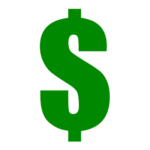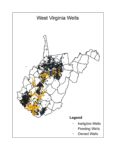This is one of the most frequently asked questions that people have when they call WVSORO.
Introduction.
Note that there are three ways for the surface owner to get damages from the driller.
1. First, damages can be agreed to and paid as part of an agreement negotiated with the driller before the well is drilled. This usually also involves a “waiver” or “statement of no objection” to the permit that includes the surface owner consenting to the locations of the well site and access road. Of course how much a surface owner gets in such negotiations often depends on how much they could get in the next two ways. (And always be sure that anything you sign that agrees to a dollar amount of damages before the well is drilled states that the dollar figure “only for foreseen” damages or does not include damages for “negligence, failure to perform workman like quality” or does “not include damages for doing more than is fairly necessary” or even (thought this is not the best) “this does not cover extraordinary damages”. Otherwise you will not be able to get additional damages if an explosion and fire burns your house, or the driller’s contractor goes wild with the bulldozer, or a land slip ends up in your pond etc.)
2. The second way to get damages occurs after the drilling is done. The driller gives the surface owner a notice that reclamation has begun and the surface owner can begin a statutory arbitration process. This process is explained in The West Virginia Surface Owner’s Guide to Oil and Gas. Our web site has a quick summary of that Guide.
While this arbitration process is designed to work without you having to hire a lawyer, we suggest you at least pay for an hour of a lawyer’s time to help you understand how to prove your damages.
Unfortunately your damages under the statutory arbitration process are limited. You only get compensated for the land taken at its current use value (as a meadow for example) and not its market value (which would be more than its meadow value if it is a good future home site). And you do not get compensated for the reduction in value of the land surrounding the land actually taken by the driller that is caused by having a well site nearby. You do get compensated for your lost crops etc. (be sure to have the timber appraised by a forester before they cut the timber if possible).
3. Finally, also after the well is drilled, you can sue in court if you think that the driller has done more than is “fairly necessary” to drill the well without properly “accommodating” or giving “due regard” to your use. If you hire a lawyer, the lawyer can use theories for claims for damages that allow you to get more kinds of damages than arbitration allows. In particular, if the original separation of owners of the minerals from the ownership of the surface was many years ago, and/or if the well site is one of the new large Marcellus Shale well sites, then the law suit can claim that the damage done by modern drilling was not “in the contemplation of the parties” at the time of the separation of ownership, etc. (We have a way for lawyers to get more information about possible theories of claims for bringing such a suit on our website.)
Unfortunately, although the damages you could get in such a suit may seem large to you, the amount of damages is usually not large enough to have enough monetary value for a lawyer to take your case on a “contingent fee” basis. A “contingent fee” is when the lawyer takes his or her pay as a % of your winnings. If the lawyer will not take your case on a contingent fee basis, you will have to pay your lawyer several thousand dollars up front to take your case. If you can afford that we encourage that — and let us know what happens. If there was significant unnecessary timber cutting there can be triple damages so a lawyer might take a contingency case in that circumstance, and there are double damages for just trespass where he did not need to go. And the size of these new Marcellus Shale wells could make it large enough for some lawyers.
Lawyers may start taking the new Marcellus Shale surface damage suits on a contingency because they cause so much more damage. Also note that driller’s should not be using your surface to drill horizontally under neighbors that were not part of your tract when the minerals and surface were separated. (Go “back” and see the separate link on this subject). If the driller uses your surface to drill horizontally under neighboring mineral interests, you may have a real claim for damages. We are not sure how to value such a claim yet, but it is significant.
You can sue yourself in Magistrate Court, but you can only sue for $5,000 dollars there. But if that is your only option, it is $5,000 you might not be able to get any other way.
What dollar amount can I get on my own?
We assume that if you are reading this, you are interested in negotiating or proceeding somehow on your own and you want to know what you could get in the statutory arbitration process.
In order to find a good answer to what you should settle for, we have tried informal surveys of surface owners who have had wells drilled on them. But those results are not useful. Many are simply fast-talked into agreeing, before drilling began, to way too little because they did not really understand what they were signing or what was going/going to go on. We found others who got more money in an up-front agreement but, particularly in the era of Marcellus Shale wells, realized after the drilling was done that they had agreed to too little. Others decided to wait for the statutory arbitration, but the reclamation notice form they received did not adequately inform them that it was time to start the process and that it was up to them to start the process, and so they never received anything. Some of those who did not agree to an amount up front were so distraught by the drilling of the well on their land that they wanted to avoid ever having to think about it again for any amount of money, so they did not pursue the money. Others who did not agree to an amount up front gave up and did not pursue arbitration figuring from their complete lack of power in the siting and drilling of the well that the company had such an upper hand that the statutory arbitration process would not turn out to be worth their time. We were not surprised that the statutory arbitration process was not used much, but we were surprised to learn that we could not find a case where it had been used — ever. So one of our members is trying it with very unsatisfying progress occurring. All the more reason to help us pass the West Virginia Surface Owners Bill of Rights.
The best information we have conventional shallow wells is from lawyers who have represented surface owners in these arbitration proceedings. Their information is that surface owners get from $5,000.00 to $15,000.00 for a conventional well site in these proceedings when represented by a lawyer. Since you are not a lawyer you might not do as well at gathering and selecting and organizing evidence and at presenting your case to the arbitrators (which is why we suggest that you get a lawyers advice before starting). On the other hand, if you would have gotten a lawyer to sue in court to get more, then the driller probably would have paid a lawyer in the court suit, so they save some money if you don’t get a lawyer and sue, so maybe you should get the same as if you did get a lawyer. And of course the amount will vary depending on how valuable your land is, how valuable your timber or other crops are, and on how big the well site is and how long and wide the road is, and you will need advice on how to prove the types of damages that will happen to your land.
We have heard rumors of surface owners getting $20,000, and as much as $50,000 for well sites, but we think this is for very serious damages at the end of very expensive litigation, or for Marcellus Shale horizontal well sites, or maybe where the surface owners also owned the minerals and had not signed a lease — so the driller had to pay the money or drill their well somewhere else — but we do not know for sure.
For Marcellus Shale horizontal well sites the driller is more likely to come to you early because they want you to sign something that waives any damages you might claim because these sites were not in the contemplation of the parties at the time the minerals were separated from the surface. In fact it is our position that they may not be able to put a horizontal well site on you at all. See our page on this. For these sites, we are hearing more recently that the numbers go way up– particularly when the driller realizes (but does not tell you) that they need your permission to drill from your surface horizontally under neighboring mineral tracts that were not part of your surface tract when the minerals were separated from the surface (all the more motivation to come to you first). You can tell that you have this leverage, and that the driller realizes it, when the surface use agreement they offer you talks about using your land to extract minerals from/drill under neighboring tracts. $15,000 is not enough for such a site. $15,000 for each well planned is more like it. We might have heard of $60,000 and more. For just the huge centralized impoundments to hold the frac water, $25,000 is appropriate. But we still do not know the limit.
Do understand that the driller can afford to pay you money. The gas in the best Marcellus Shale areas is worth $80,000 – per acre! And the liquids that come with it are worth as much. Even a shallow well costs hundreds of thousands of dollars to drill. A Marcellus Shale vertical well costs at least $1 Million to drill. A newer Marcellus Shale horizontal well costs $3 Million to $7 Million to drill. One well pad can have up to 6 or 8 or we have heard 12 horizontal wells drilled on it. You do the multiplication. So the driller has the money. It’s just that you are in a poor bargaining position so that we think that the $5,000 to $15,000 is realistic for a conventional shallow well — and if you are up against a contrary driller be ready for the long haul even for that, waiting until you get the notice of reclamation after drilling, getting our Guide, and instituting and pushing the arbitration process yourself with at least the advice of a lawyer. And for a Marcellus Shale well site, particularly a horizontal well site, you can go significantly higher than that. We think that when you hear they want to put a Marcellus Shale Horizontal Well Pad on you, you need to contact a lawyer to help gain you the bargaining leverage you need to get paid well, and to get the environmental and surface use protections that you need.




